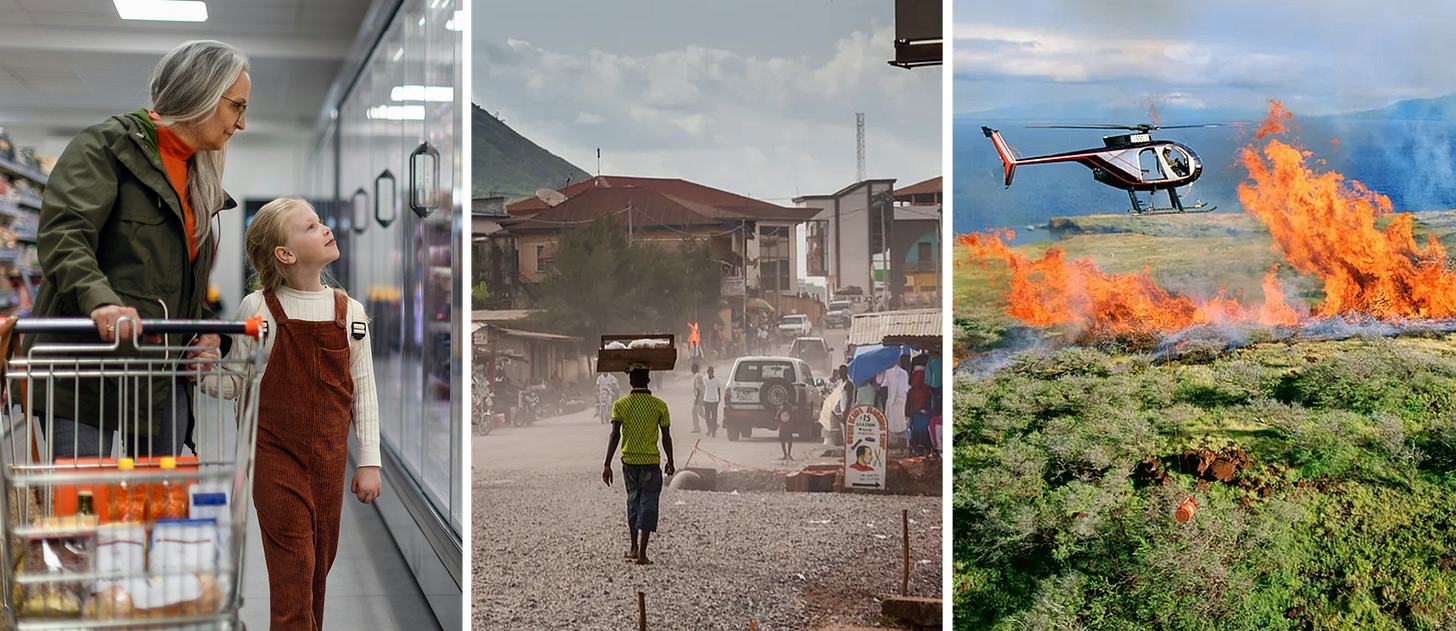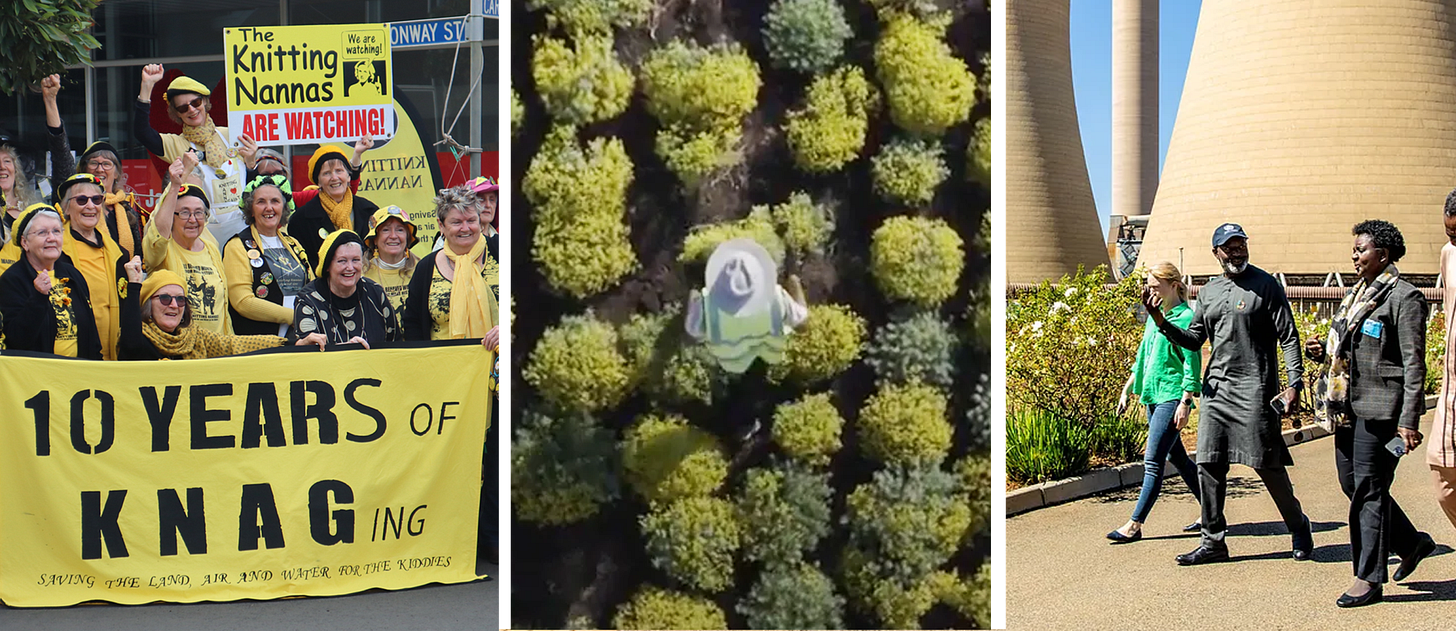2024 progress, challenges, and what you can do
A year of climate stories - the good, the not-so-good, and what you can do about it
Last week, I shared tips for navigating climate conversations over the holidays. This week, as we step into the New Year, I want to highlight some of my top stories from 2024: a mega-list of “did you know…” and “you wouldn’t believe…” conversation starters you can use to spark constructive and effective discussions in the weeks ahead.
NOT-SO-GOOD NEWS
Global warming is already affecting our food. It tripled cacao prices last year, and is contributing to rising food prices world-wide. Bananas will be harder to grow in a warmer world and coffee supply is also at risk. Warmer waters are making fish smaller, while higher levels of carbon pollution in the air is making many fruits and vegetables less nutritious.
In terms of our health, tiger mosquitoes that spread diseases including dengue, West Nile, and Chikungunya are thriving in a warmer world. In addition to causing over 8 million premature deaths each year, particulate pollution from burning fossil fuels is also responsible for up to a third of premature births worldwide.
"Extreme weather reached dangerous new heights in 2024," a report by World Weather Attribution and Climate Central found, adding that "This year’s record-breaking temperatures ... contributed to the deaths of at least 3,700 people and the displacement of millions in 26 weather events." Around the world last year, most people (probably including you!) experienced at least 41 days of extreme heat, including the heatwave that caused the deaths of some 1,300 pilgrims during this year’s Hajj.
Last year made it clear that our infrastructure isn't prepared for these impacts, either. In some places, it’s getting so hot in some places that “bridges can literally fall apart like Tinkertoys,” as one civil engineer said. 2024 saw the deadliest Atlantic hurricane season in nearly 20 years, with some communities in the Carolinas not regaining power and water for weeks afterwards. Devastating floods that destroyed homes and roads in the Philippines and Spain were also super-sized by climate change. Increasing extreme weather risk is driving up insurance prices (including where I live in Texas) and causing insurers to pull out of some areas of California, Florida, and Louisiana entirely. Around the world, one analysis estimated that all the carbon we’ve already emitted will depress global income by 19 percent.
That’s a long list! Which means, there's bound to be something whoever you’re talking with doesn't know yet but would easily relate to.
GOOD NEWS
Clean energy soared in 2024. In the US, solar and wind made up 90 percent of new capacity. Meanwhile, China installed more solar last year alone than the US has in its entire history. Its carbon emissions are about to peak, if they haven’t already, and within a decade China will be generating more electricity from solar alone than the US uses in total.
When it comes to clean energy, there’s no silver bullet; we need everything we can get, and every year people are coming up with creative ways to provide the power we need. For example, by building new renewable projects near soon-to-be retired fossil fuel plants, operators can repurpose existing grid connections, like at the Sherco coal power plant in Minnesota. The Ulkatcho First Nation in British Columbia plans to build Canada’s largest off-grid solar farm to date. And new electric cargo ships are sailing in China and Norway now.
Working with nature to generate climate solutions can add a whole new set of benefits. Last year, for example, in the depths of the Mediterranean Sea, scientists discovered a type of cyanobacteria that consumes carbon dioxide astonishingly quickly. An Albanian start up is trying to mine nickel - a crucial metal for manufacturing EV batteries - from plants. A new UK law requires new development to demonstrate “biodiversity net gain” – leaving the natural environment measurably better than it was before! Pollinator-friendly solar farms can help tackle the biodiversity crisis and the climate crisis at the same time, and Priyanka Singh taught us that even a balcony in Mumbai can be turned into a pollinator haven.
A four-day workweek reduces both carbon pollution and increases worker happiness. In Scotland, the city of Edinburgh has barred airlines, SUVs, cruise lines, and oil companies from advertising in city limits. Universities across the US and the world, from UC San Diego to the University of Barcelona, are adding courses on climate change to their graduation requirements. Education will be key to how we solve this problem, so this is something to celebrate!
Musicians and grandmothers were my favourite climate messengers of 2024: from Australia’s Knitting Nannas, who show up in bright yellow shirts, knitting in hand, and pull up a chair to protest everything from unfair legislation to coal expansion, to Coldplay, who cut their tour emissions by almost 60 percent. And there’s even a concert venue in Scotland that is heated and cooled using the body heat of concertgoers.
Wherever we look, climate solutions are proving it is 100 percent possible to tackle big challenges while building a better and healthier world for ourselves and for generations to come.
WHAT YOU CAN DO
At home, you can take a big bite out of your carbon footprint by electrifying everything from appliances to heating and cooling. Rewiring America has a handy Personal Electrification Planner for both home-owners and renters. You can also take steps to prepare for hurricane season or other climate-fueled extreme weather disasters. And online, consider switching your search engine to Ecosia, which plants one tree for every 45 searches.
A great place to engage in effective climate action is at the level of your local neighborhood association or other local organization. Climate Herald has a handy tool to help you find an organization near you that might be a good fit. And while you’re at it, ask any organizations you’re involved with to cut their plastic use, reduce their food waste, and recycle their aluminum and paper waste.
Schools, from their buses to how they heat and cool their buildings, have a large carbon footprint, but there are plenty of ways to cut those emissions, starting with your local school board. Students, too, can use their voices; like the middle schoolers in California who got their school to swap out an inefficient gas boiler for a new heat pump.
And don’t forget that the most impactful climate action you can take has nothing to do with your personal carbon footprint! Here is as list of the most effective ways individuals can catalyze change:
Start a conversation about why climate change matters and what people can do about it
Join a climate action group to amplify your voice and others
Consider where you keep and how you spend your money (including your bank, credit card, retirement, and purchases)
Spark ideas for change at work, school, church, or any other organization you are part of
Hold politicians at every level accountable by voting and by telling them why climate change matters and what you want them to do about it (this includes showing up at town hall meetings!)
Reduce your personal footprint and make your actions contagious by talking about them with people you know and encouraging them to do the same
As environmentalist and Third Act founder
often says, “the most important thing an individual can do is not be such an individual. Join together with others to make change!"Wed Jan 29 at 6:30pm ET - Envisioning a Livable Future with Nancy Tuchman, Benjamin Sovacool, and John Carroll University - in person at John Carroll University in University Heights, Ohio, and online; registration link above.






Danke bitte weiter so 👍💯❤️🙏
Great post Katharine!! I’ve shared it with others this morning, as excellent information for New Year’s resolutions, and will do so in the days ahead!